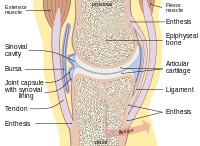
Photo from wikipedia
Introduction: Referred pain in the anterior knee joint is the most common symptom in hip disease patients. The development of referred pain is considered to be related to dichotomizing peripheral… Click to show full abstract
Introduction: Referred pain in the anterior knee joint is the most common symptom in hip disease patients. The development of referred pain is considered to be related to dichotomizing peripheral sensory fibers. However, no gross anatomical findings identify any dichotomizing fibers innervating both the hip and knee joints. We dissected the femoral and obturator nerves in human cadavers to investigate the distribution of the articular branches in the hip and knee joints. Fourteen embalmed left lower limbs from 14 Japanese adult cadavers (five from females, nine from males, average age 73.8 ± 14.1 years) were observed macroscopically. The articular branches of the femoral and obturator nerves were dissected at the anterior margin of the groin toward the thigh region. After dissections of the articular nerves of the hip joints, the femoral and obturator nerves were exposed from proximally to distally to identify the articular nerves of the knee joints. The branching pattern of the articular branches in the hip and knee joints was recorded. In six of 14 limbs (42.9%), the femoral nerve supplied articular branches to the anteromedial aspect of both the hip and knee joints. These articular branches were derived from the same bundle of femoral nerve. These gross anatomical findings suggested that dichotomizing peripheral sensory fibers innervate the hip and knee joints and these could relate to the referred pain confirmed in the anterior knee joints of patients with hip disease. Clin. Anat. 31:705–709, 2018. © 2018 Wiley Periodicals, Inc.
Journal Title: Clinical Anatomy
Year Published: 2018
Link to full text (if available)
Share on Social Media: Sign Up to like & get
recommendations!